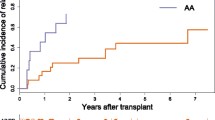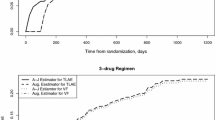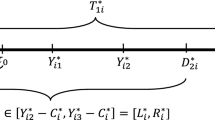Abstract
This article considers the problem of competing risks analysis in the presence of middle censoring scheme. In this censoring, the exact lifetime of the subject under study becomes unobservable when it falls in a random censoring interval and the associated competing causes of failure can be identified in later inspection. We consider the cumulative incidence function for evaluation of competing risks by assuming a Weibull cause specific hazard function with the common shape parameter for all competing causes. Maximum likelihood and midpoint approximation methods are employed for point estimation of unknown parameters and cumulative incidence functions. Asymptotic confidence intervals of maximum likelihood estimators are computed. In addition, the Bayes estimators and the associated credible intervals are also considered. The Monte Carlo simulation and an illustrative example on bone marrow transplant data are given for comprehensive comparison of proposed methods.


Similar content being viewed by others
Availability of data and material
The data set used in manuscript is available in Klein and Moeschberger (2003) on page 12 in Section 1.10.
Code availability
The R codes for simulation and data analysis are available in Electronic Supplementary Material.
References
Abuzaid, A., El-Qumsan, M. A., & El-Habil, A. (2017). On the robustness of right and middle censoring schemes in parametric survival models. Communications in Statistics-Simulation and Computation, 46(3), 1771–1780.
Ahmadi, K., Rezaei, M., & Yousefzadeh, F. (2017). Statistical analysis of middle censored competing risks data with exponential distribution. Journal of Statistical Computation and Simulation, 87(16), 3082–3110.
Bakoyannis, G., Chu, F. I., Babiker, A. G., & Touloumi, G. (2021). Impact of covariate omission and categorization from the fine-gray model in randomized-controlled trials. Japanese Journal of Statistics and Data Science. https://doi.org/10.1007/s42081-021-00111-5.
Beyersmann, J., Allignol, A., & Schumacher, M. (2012). Competing risks and multistate models with R. Springer Science & Business Media.
Chen, D., & Lio, Y. (2010). Parameter estimations for generalized exponential distribution under progressive type-i interval censoring. Computational Statistics & Data Analysis, 54(6), 1581–1591.
Cox, D. R. (1972). Regression models and life-tables. Journal of the Royal Statistical Society: Series B (Methodological), 34(2), 187–220.
Fan, T. H., Wang, Y. F., & Ju, S. K. (2019). A competing risks model with multiply censored reliability data under multivariate Weibull distributions. IEEE Transactions on Reliability, 68(2), 462–475.
Fine, J. P., & Gray, R. J. (1999). A proportional hazards model for the subdistribution of a competing risk. Journal of the American statistical association, 94(446), 496–509.
Jammalamadaka, S. R., & Mangalam, V. (2003). Nonparametric estimation for middle-censored data. Journal of nonparametric statistics, 15(2), 253–265.
Jeong, J. H., & Fine, J. (2006). Direct parametric inference for the cumulative incidence function. Journal of the Royal Statistical Society: Series C (Applied Statistics), 55(2), 187–200.
Kalbfleisch, J. D., & Prentice, R. L. (2002). The statistical analysis of failure time data (Vol. 360). Wiley. https://doi.org/10.1002/9781118032985
Klein, J. P., & Moeschberger, M. L. (2003). Survival analysis: Techniques for censored and truncated data. Springer.
Li, C. (2016). Cause-specific hazard regression for competing risks data under interval censoring and left truncation. Computational Statistics & Data Analysis, 104, 197–208.
Li, C. (2016). The fine-gray model under interval censored competing risks data. Journal of Multivariate Analysis, 143, 327–344.
Lipowski, C., Lo, S. M., Shi, S., & Wilke, R. A. (2021). Competing risks regression with dependent multiple spells: Monte carlo evidence and an application to maternity leave. Japanese Journal of Statistics and Data Science. https://doi.org/10.1007/s42081-021-00110-6.
Lo, S. M., Mammen, E., & Wilke, R. A. (2020). A nested copula duration model for competing risks with multiple spells. Computational Statistics & Data Analysis, 150, 106986.
Lunn, D., Jackson, C., Best, N., Spiegelhalter, D., & Thomas, A. (2012). The BUGS book: A practical introduction to Bayesian analysis. Chapman and Hall/CRC.
Prentice, R. L., Kalbfleisch, J. D., Peterson, A. V., Jr., Flournoy, N., Farewell, V. T., & Breslow, N. E. (1978). The analysis of failure times in the presence of competing risks. Biometrics, 34(4), 541–554.
Rivest, L. P., & Wells, M. T. (2001). A martingale approach to the copula-graphic estimator for the survival function under dependent censoring. Journal of Multivariate Analysis, 79(1), 138–155.
Robert, C. P., & Casella, G. (2010). Introducing Monte Carlo methods with R (Vol. 18). Springer Science & Business Media.
Teimouri, M., & Gupta, A. K. (2012). Estimation methods for the gompertz-makeham distribution under progressively type-i interval censoring scheme. National Academy Science Letters, 35(3), 227–235.
Tsiatis, A. (1975). A nonidentifiability aspect of the problem of competing risks. Proceedings of the National Academy of Sciences, 72(1), 20–22.
Wang, L. (2016). Estimation for exponential distribution based on competing risk middle censored data. Communications in Statistics-Theory and Methods, 45(8), 2378–2391.
Wang, Y. C., Emura, T., Fan, T. H., Lo, S. M., & Wilke, R. A. (2020). Likelihood-based inference for a frailty-copula model based on competing risks failure time data. Quality and Reliability Engineering International, 36(5), 1622–1638.
Zhang, Z., & Sun, J. (2010). Interval censoring. Statistical Methods in Medical Research, 19(1), 53–70.
Acknowledgements
The authors are grateful to the journal’s Editors and anonymous referees for their helpful and constructive comments that helped to improve the manuscript.
Funding
The authors did not receive support from any organization for the submitted work.
Author information
Authors and Affiliations
Ethics declarations
Conflict of interest
The authors declare that they have no conflict of interest.
Additional information
Publisher's Note
Springer Nature remains neutral with regard to jurisdictional claims in published maps and institutional affiliations.
Supplementary Information
Below is the link to the electronic supplementary material.
Appendix
Appendix
Here we provide the details of system of score equations used in Sect. 3.1. First, we define some notations for reducing the length of expressions
From Eq. (9) we obtain the partial derivatives of log-likelihood with respect to each parameter by the following equations.
The observed Fisher information matrix is given by
The elements of \({\varvec{I}}_{O}({\varvec{\varTheta }})\) are given below.
The other mixed partial derivatives can also be obtained.
Score equations under the MPA method are given below
The variance formula of the CIF is given by
Rights and permissions
About this article
Cite this article
Rehman, H., Chandra, N. Inferences on cumulative incidence function for middle censored survival data with Weibull regression. Jpn J Stat Data Sci 5, 65–86 (2022). https://doi.org/10.1007/s42081-021-00142-y
Received:
Revised:
Accepted:
Published:
Issue Date:
DOI: https://doi.org/10.1007/s42081-021-00142-y
Keywords
- Cumulative incident function
- Cause specific hazard
- Maximum likelihood
- Midpoint approximation
- Bayes estimator
- Credible interval
- MCMC algorithm




